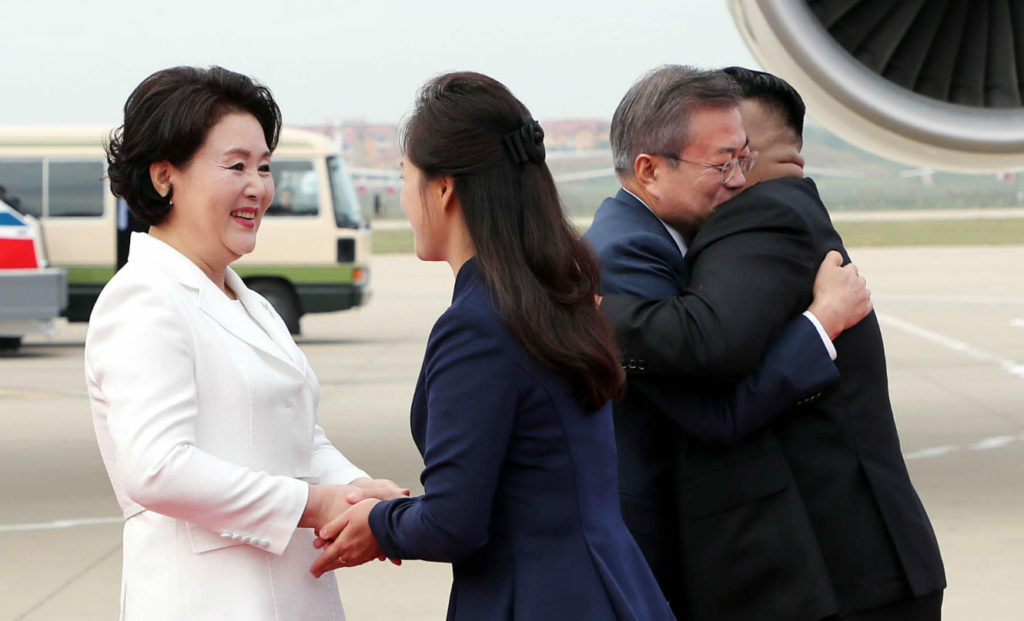A Challenge and an Opportunity in the Latest Inter-Korean Military Agreement

The heavy scrutiny of North Korea’s promises on denuclearization at the September North-South summit in Pyongyang buried otherwise important progress: If the new inter-Korean military agreement signed by the leaders of the two Koreas is implemented, the chances of accidents or miscalculation escalating to full-blown war will decline. But there is an inherent contradiction in the agreement that presents both a serious challenge to its implementation and an opportunity to bolster progress toward a stable peace on the peninsula.
The contradiction is located in the third paragraph of the agreement, which establishes no-fly zones near the military demarcation line that divides the two Koreas for fixed-wing and rotary aircraft, manned or unmanned. These zones are intended to decrease the likelihood that air operations might inadvertently raise tensions or lead to accidental conflict.
Some observers complained that these zones disproportionately affect South Korea by eroding its significant surveillance and reconnaissance advantage over North Korea. The rough mountainous and forested terrain in the demilitarized zone that surrounds the military demarcation line makes aerial monitoring arguably the single most important means of observing military activity on either side, especially for purposes of operational readiness and warning. In agreeing to these restraints, some critics contend that South Korean President Moon Jae-in “risks going too far by lowering allied defenses before North Korea’s conventional threat to South Korea, and U.S. troops stationed there, is reduced.” Since U.S. forces in Korea operate through a Combined Forces Command jointly with South Korean forces, the new inter-Korean agreement presumably places new restrictions on aerial support for U.S. personnel deployed at bases within the no-fly zones.
Yet there is a more pernicious problem. By limiting aerial observation through no-fly zones, the two sides will be less able to actually verify compliance with many of the restraint measures contained in the agreement, such as the proscription on artillery exercises near the military demarcation line. Essentially, the agreement blindfolds both parties such that they will have difficulty confirming that the other side is adhering to the deal – which could diminish the agreement’s ability to deter cheating. Importantly, this limitation portends great difficulty verifying other long-sought military confidence-building measures, such as the withdrawal of deployed artillery pieces or multiple rocket launch systems.
Though South Korea and the United States have satellite and other remote sensing platforms to mitigate data loss from the cessation of aerial monitoring, North Korea does not. Unless it receives such information from a third party such as China, North Korea will be relatively more blind to activity south of the military demarcation line. Pyongyang’s inability to verify Seoul’s compliance with the agreement could well lead to false claims of cheating or worse by North Korea down the road. The bottom line is that given minimal trust between the two Koreas resulting from failures to implement similar prior agreements, verifying military restraint measures is necessary to actually reduce the probability of escalation.
This contradiction in an agreement intended to reduce military tensions could be a critical flaw, but it also presents an opportunity to establish new means of cooperative monitoring that could fill the information gap for both North and South Korea. The idea would be to establish, under the auspices of the inter-Korean military committee created by the September agreement, a system for observation for purposes of verifying agreed military restraints. For instance, the two could undertake joint air patrols on designated aircraft that would utilize commercially available photo equipment or other methods to provide validated and shared information. Such an approach could help the two sides affirm compliance with limits on military activity in the buffer zones on either side of the military demarcation line, as well as deepen patterns of regular military cooperation. Given the involvement of U.S. and U.N. forces in this theater, multi-party or third-party monitoring may facilitate the necessary information-sharing and extend the potential confidence-building benefits.
In other words, joint monitoring would give both sides the same information and a means of resolving any concerns about compliance. It would also forge a degree of cooperation that could be a building block for future peacebuilding agreements. The existence of the military demarcation zone means the potential for cooperative monitoring has, in theory, always existed. But the recent agreement makes such monitoring especially necessary because the no-fly zones limit independent verification.
Cooperative monitoring is not a new idea, of course. Following diplomatic warming in the early 1990s and again during the era of South Korea’s “sunshine” policy in the 2000s, Korean and American experts developed a range of ideas for implementing cooperative monitoring systems to help reduce instability and build confidence on the Korean Peninsula.
These ideas have gathered dust over the last decades, but today it is worth revisiting how they might now help the two Koreas break the cycle of crisis and solidify a lasting peace. The agreement to reduce military tensions has real potential to lower the risk of war and be a building block for lasting peace on the peninsula, but only if this contradiction is managed in a way that provides maximum opportunity for cooperation between these bitter rivals.
Toby Dalton is co-director of the Nuclear Policy Program at the Carnegie Endowment for International Peace, where he works on regional security challenges issues in East and South Asia. He previously served as senior policy advisor in the Office of Nonproliferation and International Security, U.S. National Nuclear Security Administration. Follow him @toby_dalton on Twitter.

